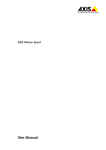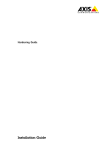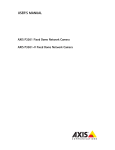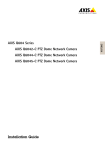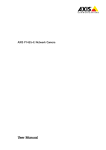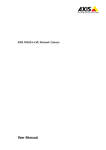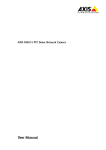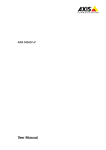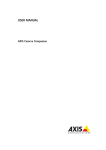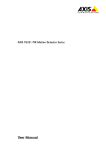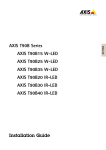Download AXIS Loitering Guard User Manual
Transcript
AXIS Loitering Guard User Manual About This Document Learn More! This manual is intended for administrators and users of the application AXIS Loitering Guard version 1.0. Later versions of this document will be posted to Axis website, as required. See also the online help, available from the application’s webpages. Visit Axis learning center www.axis.com/academy/ for useful trainings, webinars, tutorials and guides. Legal Considerations Video and audio surveillance can be regulated by laws that vary from country to country. Check the laws in your local region before using this product for surveillance purposes. Liability Every care has been taken in the preparation of this document. Please inform your local Axis office of any inaccuracies or omissions. Axis Communications AB cannot be held responsible for any technical or typographical errors and reserves the right to make changes to the product and manuals without prior notice. Axis Communications AB makes no warranty of any kind with regard to the material contained within this document, including, but not limited to, the implied warranties of merchantability and fitness for a particular purpose. Axis Communications AB shall not be liable nor responsible for incidental or consequential damages in connection with the furnishing, performance or use of this material. This product is only to be used for its intended purpose. Intellectual Property Rights Axis AB has intellectual property rights relating to technology embodied in the product described in this document. In particular, and without limitation, these intellectual property rights may include one or more of the patents listed at www.axis.com/patent.htm and one or more additional patents or pending patent applications in the US and other countries. This product contains licensed third-party software. See the menu item “About” in the product’s user interface for more information. This product contains source code copyright Apple Computer, Inc., under the terms of Apple Public Source License 2.0 (see www.opensource.apple.com/apsl). The source code is available from https://developer.apple.com/bonjour/ Trademark Acknowledgments AXIS COMMUNICATIONS, AXIS, ETRAX, ARTPEC and VAPIX are registered trademarks or trademark applications of Axis AB in various jurisdictions. All other company names and products are trademarks or registered trademarks of their respective companies. Apple, Boa, Apache, Bonjour, Ethernet, Internet Explorer, Linux, Microsoft, Mozilla, Real, SMPTE, QuickTime, UNIX, Windows, Windows Vista and WWW are registered trademarks of the respective holders. Java and all Java-based trademarks and logos are trademarks or registered trademarks of Oracle and/or its affiliates. UPnPTM is a certification mark of the UPnPTM Implementers Corporation. Contact Information Axis Communications AB Emdalavägen 14 223 69 Lund Sweden Tel: +46 46 272 18 00 Fax: +46 46 13 61 30 www.axis.com Support Should you require any technical assistance, please contact your Axis reseller. If your questions cannot be answered immediately, your reseller will forward your queries through the appropriate channels to ensure a rapid response. If you are connected to the Internet, you can: • download user documentation and software updates • find answers to resolved problems in the FAQ database. Search by product, category, or phrase • report problems to Axis support staff by logging in to your private support area • chat with Axis support staff • visit Axis Support at www.axis.com/techsup/ AXIS Loitering Guard Table of Contents Application Overview . . . . . . . . . . . . . . . . . . . . . . . . . . . . . . . . . . . . . . . . Requirements . . . . . . . . . . . . . . . . . . . . . . . . . . . . . . . . . . . . . . . . . . . . . . . . . . Considerations . . . . . . . . . . . . . . . . . . . . . . . . . . . . . . . . . . . . . . . . . . . . . . . . . . Install Application . . . . . . . . . . . . . . . . . . . . . . . . . . . . . . . . . . . . . . . . . . Install License . . . . . . . . . . . . . . . . . . . . . . . . . . . . . . . . . . . . . . . . . . . . . . . . . . Start and Stop the Application . . . . . . . . . . . . . . . . . . . . . . . . . . . . . . . . . . . . . Configure the Application . . . . . . . . . . . . . . . . . . . . . . . . . . . . . . . . . . . . Profiles . . . . . . . . . . . . . . . . . . . . . . . . . . . . . . . . . . . . . . . . . . . . . . . . . . . . . . . . Multichannel Products . . . . . . . . . . . . . . . . . . . . . . . . . . . . . . . . . . . . . . . . . . . AXIS Loitering Guard Setup . . . . . . . . . . . . . . . . . . . . . . . . . . . . . . . . . . . . . . . Include and Exclude Areas . . . . . . . . . . . . . . . . . . . . . . . . . . . . . . . . . . . . . . . . Loitering Criteria . . . . . . . . . . . . . . . . . . . . . . . . . . . . . . . . . . . . . . . . . . . . . . . . Small Objects . . . . . . . . . . . . . . . . . . . . . . . . . . . . . . . . . . . . . . . . . . . . . . . . . . . Swaying Objects . . . . . . . . . . . . . . . . . . . . . . . . . . . . . . . . . . . . . . . . . . . . . . . . Visual Confirmation . . . . . . . . . . . . . . . . . . . . . . . . . . . . . . . . . . . . . . . . . . . . . . Using the Application in an Action Rule . . . . . . . . . . . . . . . . . . . . . . . . . 3 4 4 4 5 5 5 7 7 7 8 8 9 9 11 11 12 AXIS Loitering Guard Application Overview Application Overview AXIS Loitering Guard monitors an area of interest and sends an alarm if people, vehicles or other objects are loitering in the area. An object is considered loitering if it stays too long in the area or if it is inactive for too long. The alarm can be used by Axis network cameras and video encoders, and by third-party software, to, for example, record video and alert security staff. To reduce false alarms, use filters to ignore objects such as swaying foliage and small animals. To use AXIS Loitering Guard, the application must be uploaded to an Axis network camera or video encoder, the license must be installed and the application must be started. To configure the application, use AXIS Loitering Guard Setup which is started automatically if the application is not yet configured. Use profiles to create multiple configurations, for example for daytime and nighttime or for different parts of the scene. Each profile has its own settings and generates its own alarms. Requirements The application can be installed in Axis network cameras and video encoders that support AXIS Camera Application Platform. A complete list of compatible products and firmware versions is available at www.axis.com/applications For full functionality, Internet Explorer and AXIS Media Control (AMC) are required when configuring the application and when using visual confirmation. Considerations Before using the application, take the following into consideration: • To use perspective when the monitored area has significant differences in elevation, create multiple profiles and configure perspective in each profile. See Profiles. • Small and distant objects might not be detected. • Detection accuracy may be affected by weather conditions such as heavy rain or snow. • Make sure that the lighting conditions are within the Axis product’s specification. Use additional lighting if needed. • Make sure that the camera is not subject to excessive vibrations. Vibrations might cause false detections. 4 AXIS Loitering Guard Install Application Install Application To download the application, go to www.axis.com/applications. There are two installation packages: • Application only. Select this option if the application is to be configured from a computer with Internet access. • Stand-alone installer containing the application and AXIS Media Control (AMC) installer. Select this option if the application is to be configured from a computer without Internet access. AXIS Media Control is a software component for viewing video in Internet Explorer. For full functionality, AXIS Media Control is required when configuring the application. If the application is configured from a computer with Internet access, AXIS Media Control is downloaded and installed automatically. If the application is configured from a computer without Internet access, AXIS Media Control must be installed separately. Select the stand-alone installer package, unzip the file and run the AXIS Media Control installer. Install the application as described below. To install the application in an Axis network camera or video encoder, follow these steps: 1. Download the application as described above. 2. Go to Setup > Applications in the Axis product’s webpages. 3. Under Upload Application, click Browse, locate the application file and then click Upload Package. The application appears under Installed Applications in the Applications page and under Overview in the menu. Note Uploading applications requires administrator rights. Install License To start the application, a license key file is required. The license key is unique to the Axis product and is based on the product’s serial number. If the Axis network camera or video encoder is connected to a network with Internet access, the license key file can be requested directly from the product’s webpages. 1. Go to Applications > AXIS Loitering Guard > License. 2. Automatic installation appears on the webpage. Enter the required information. 3. Click Install. Alternative method: If the camera is connected to a network without Internet access, the key must first be retrieved from www.axis.com 1. Go to www.axis.com/applications and click License key registration. Select the application and enter the Axis product’s serial number (S/N). 2. Save the license key file. 3. Open the Axis product’s webpages and go to Applications > AXIS Loitering Guard > License. 4. Under Manual installation, click Browse and browse to the license key file. 5. Click Install. Start and Stop the Application To start the application, select it in the Installed Applications list on the Applications page and click Start. 5 AXIS Loitering Guard Install Application To stop the application, select it in the list and click Stop. 6 AXIS Loitering Guard Configure the Application Configure the Application The application is available from Setup > Applications > AXIS Loitering Guard. Go to Settings and then click Main page to open the application’s webpage. AXIS Loitering Guard Setup starts automatically if the application is not configured. Once the application is configured, the application's main page can be used for visual confirmation and to modify settings. For information about visual confirmation, see Visual Confirmation. For information about profiles, see Profiles. To edit settings, first select the profile from the Profiles list and then select the appropriate setting: • To change the include and exclude areas, click Edit areas. See Include and Exclude Areas. • To change the loitering criteria, click Time alarm or Inactivity alarm. See Time Alarm and Inactivity Alarm. • To change the small object filter, click Small objects. See Small Objects. • To change the swaying object filter, click Swaying objects. See Swaying Objects. Profiles Profiles make it possible to create multiple configurations, for example one configuration for daytime and one for nighttime or configurations with different include areas. Each profile triggers its own alarms and has its own settings. Axis cameras and third-party software that listen to alarms from the application can be configured to respond differently when receiving alarms from different profiles. For example, to use one configuration for daytime and one for nighttime, create two profiles with different settings. In the Axis product, create one action rule for each profile and use daytime and nighttime schedules as additional conditions. If the camera monitors an area with differences in elevation, profiles can be used to create configurations with different perspective setup to make it possible to use the small object with perspective filter. Divide the area into regions without significant elevation differences and create one profile for each region. In each profile, modify the include area to cover the region and calibrate perspective in the region instead of in the whole image. To switch between profiles, select the profile from the drop-down list in the main page. Create, Edit and Delete Profiles The first profile is created automatically. Additional profiles can be created by selecting Save & Continue in AXIS Loitering Guard Setup or by selecting Profiles > New profile from the main page. To simplify configuration, new profiles can be based on existing profiles. Select Copy settings from profile and then select the profile to copy. To edit an existing profile, click Start application setup in the main page to restart AXIS Loitering Guard Setup. Alternatively, select the profile in the main page and then select the setting to change. To rename or delete an existing profile, select Profiles > Manage profiles in the main page. Note If deleting a profile that is used by an action rule or by third-party software, also delete or reconfigure the action rule or third-party software. Multichannel Products For multichannel products such as video encoders and cameras with multiple camera heads, the application can be used on all channels. Each channel has its own settings. 7 AXIS Loitering Guard Configure the Application Note For some video encoders, the application can only be used on one channel at a time. Go to www.axis.com/applications for a list of compatible products. To use the application on a multichannel product, the application must be enabled and configured for each camera. • To switch between cameras, click on the tabs below the video image. • To enable the application on a camera, switch to that camera and click Enable. When configuring the application using AXIS Loitering Guard Setup, select the camera to configure. A green check mark indicates that the camera is configured. A red check mark indicates that the camera has been configured but needs to be reconfigured, for example because the image has been rotated. AXIS Loitering Guard Setup AXIS Loitering Guard Setup starts automatically if the application is not configured. Setup includes the following steps: 1. Select the profile to configure (not available when running Setup for the first time). 2. Configure include and exclude areas. 3. Configure the loitering criteria: time alarm and inactivity alarm. 4. Configure the small object filter. 5. Configure the swaying object filter. 6. Save the profile. To continue configuring another profile, select Save & Continue. To close Setup and return to the main page, select Save & Close. To restart AXIS Loitering Guard Setup, click the link Start application setup in the application’s main page. All currently configured values will be kept when setup is restarted. Note Perspective configuration is only available through AXIS Loitering Guard Setup. Include and Exclude Areas The include area is the area in which loitering objects trigger alarms. Objects outside the include area are ignored. Objects trigger alarms also if only a part of the object is inside the include area. Exclude areas are areas in which loitering objects are ignored. Use exclude areas if there are regions inside the include area that trigger unwanted alarms. Include and exclude areas are set up when the application is configured using AXIS Loitering Guard Setup. To change the areas, click Edit areas in the main page. To edit the include and exclude areas: 1. Use the mouse to reshape and resize the include area so that it only covers the part of the image where objects should trigger alarms. - To add a new area corner, click on the area border. Drag the corner to the desired position. - To remove a corner, right-click on the corner. - To move the entire include area, place the mouse pointer inside the area. When the pointer becomes a cross, drag the area to the new position. 8 AXIS Loitering Guard Configure the Application 2. To ignore areas inside the include area, add one or more exclude areas. Reshape, resize and move the exclude areas as described above. To maximize the include area, click Maximize. Loitering Criteria Loitering criteria define when the application considers an object to be loitering and sends an alarm. The criteria are set up when the application is configured using AXIS Loitering Guard Setup. To change the criteria, select the profile and click Time alarm or Inactivity alarm in the main page. • Time alarm: Alarm when an object stays too long in the include area. • Inactivity alarm: Alarm when an object in the include area is inactive for too long. Note Time alarm, inactivity alarm or both must be enabled. If both are disabled, the application will not trigger alarms. Time Alarm When the time alarm is enabled, the application sends an alarm if an object stays too long in the include area. 1. Click Enable to enable the alarm. 2. Enter the maximum allowed time. Objects that stay longer will trigger an alarm. When the time alarm is enabled, the application keeps track of how long each object has stayed in the include area. If two or more objects move close together, they sometimes merge. The merged object is considered a new object and inherits the time from the object that has the longest time. In visual confirmation, the upper progress bar shows the time the object has been in the include area. The time starts counting when the object enters the include area. If the object leaves the include area, but stays in the camera’s view, it keeps its time. The time count continues if the object re-enters the include area. This means that if an object triggers an alarms and leaves the include area, a new alarm will be triggered immediately when the object re-enters the include area. Inactivity Alarm When the inactivity alarm is enabled, the application sends an alarm if an object in the include area is inactive for too long. An inactive object is an object that moves slower than the speed threshold. In AXIS Loitering Guard Setup, the threshold is visualized by a moving ball. Objects moving slower than the ball trigger alarms. 1. Click Enable to enable the alarm. 2. Enter the maximum allowed inactive time. Objects that are inactive longer trigger alarms. 3. Enter a value for speed threshold. To test the threshold, compare the speed of the ball with objects in the scene. Use the mouse to move the ball and change its direction. De-select the ball to resume the animation. In visual confirmation, the lower progress bar shows the time the object has been inactive. Small Objects The small object filter reduces false alarms by ignoring objects that are small, for example small animals. The filter is applied to all objects in the scene. The filter is set up when the application is configured using AXIS Loitering Guard Setup. To change the filter, click Small objects in the main page. Supported small object filters: • Small object filter with perspective provides the best false alarm reduction and is recommended for most installations. Select this option when the image has a significant depth, that is, when objects far from the camera appear smaller than objects close to the camera. See Small Objects with Perspective. 9 AXIS Loitering Guard Configure the Application • Small object filter without perspective is recommended if there is no or only a small depth in the image and in situations where perspective cannot be used, for example if the camera has a bird's-eye view or monitors an area with significant differences in elevation. See Small Objects without Perspective. Small Objects with Perspective When Small object with perspective is selected, the small object filter size is the size of the physical object. In the setup window, the filter is visualized as a rectangle. Objects that fit inside the rectangle are ignored. When dragged and dropped at different scene locations, the rectangle size is adapted to reflect how objects appear at different distances from the camera. Perspective is set up when configuring the application using AXIS Loitering Guard Setup. See Perspective Calibration. To restart setup, click on the link Start application setup in the main page. To edit the filter: 1. Click Enable to enable the filter. 2. Enter the object height and width in the fields. Smaller objects are ignored and do not trigger alarms. To be ignored, objects must be smaller than both values. Perspective Calibration Perspective needs to be calibrated if the image has a significant depth, that is, if objects far from the camera appear smaller than objects close to the camera. During calibration, the application compares object heights as they appear in the image with the heights of the corresponding physical objects. After calibration, the application uses the calibrated perspective to calculate the object size before applying the small object filter. Perspective is calibrated by positioning vertical bars in the image. The bars represent physical objects at different distances from the camera. Use at least two bars. Adding additional bars improves calibration. To calibrate perspective: 1. Place the bars at objects of known heights. Use objects that stand on the ground, for example humans or fence poles. 2. Modify the height of each bar to match the height of the object as it appears in the image. 3. For each bar, enter the corresponding object’s height in the field. Use centimeters or feet and inches. 4. Click Add bar to add additional bars. Example: If there is a fence with 2 meter high poles extending from the camera towards the horizon, position the bars at the fence poles, adjust their heights and enter 200 cm (6 ft 7 in) in the fields. Perspective can only be calibrated using AXIS Loitering Guard Setup. To restart setup, click on the link Start application setup in the main page. Small Objects without Perspective If the option Small object filter without perspective is selected, the filter size is the size of the object as it appears in the image. Take into consideration that an object far from the camera appears smaller than an object close to the camera. In the setup window, the filter is visualized as a rectangle. Objects that fit inside the rectangle are ignored. To edit the filter: 1. Click Enable to enable the filter. 2. Use the mouse to resize the filter. Objects that fit inside the rectangle are ignored. The filter displayed in the image can be moved to make it easier to compare the filter size with the size of objects in the image. The filter is applied to all objects in the image, also to objects that are not located at the position of the displayed filter. The filter size can also be set by entering the width and height in the fields. The width and height are measured in percent of the image width and height. Smaller objects are ignored and do not trigger alarms. To be ignored, an object must be smaller than both values. 10 AXIS Loitering Guard Configure the Application Swaying Objects The swaying object filter reduces false alarms by ignoring objects that only move a short distance, for example swaying foliage, flags and their shadows. Use the filter if such objects cause a lot of false alarms. If the swaying objects are large, for example large ponds or large trees, use exclude areas instead of the filter. The filter is applied to all detected objects and if set to a too large value, important objects might not trigger alarms. When the swaying object filter is enabled and the application detects an object, the object will not trigger an alarm (red in visual confirmation) until it has travelled a distance larger than the filter size. If the alarm is used to start a recording, configure the pre-trigger time so that the recording also includes the time the object moved in the scene before the alarm was sent. The filter is set up when the application is configured using AXIS Loitering Guard Setup. To change the filter, click Swaying objects in the main page. To edit the filter: 1. Click Enable to enable the filter. 2. Use the mouse to resize the filter. Start with a small size. Objects moving a distance that is shorter than the distance from the ellipse center to one of the arrowheads are ignored. The filter displayed in the image can be moved to make it easier to compare the filter size with the size of objects in the image. The filter is applied to all objects in the image, also to objects that are not located at the position of the displayed filter. Note If the swaying object filter is too large, objects might not fulfill the loitering criteria and will not trigger alarms. Reduce the swaying object filter or increase the allowed time in the time and/or inactivity alarms. Visual Confirmation Visual confirmation is used to validate that the settings are correct, that is, that all objects that should be detected are detected and trigger alarms. Note To use visual confirmation, Internet Explorer and AXIS Media Control (AMC) must be used. When visual confirmation is enabled, all moving objects found by the application are encircled and followed by rectangles. • Red: The object has triggered an alarm. • Yellow: The object is ignored because of an ignore filter. • Green: The object is found but has not triggered an alarm because it is not in the include area or does not fulfill the loitering criteria. The two progress bars below each moving object show the time the object has spent in the include area (upper bar) and the time the object has been inactive (lower bar). To enable visual confirmation, click on the Visual confirmation slider. To switch between profiles, select the profile from the drop-down list. Note • The rectangles may sometimes lag behind the moving objects. The lag is only in visual confirmation; it does not affect the application’s detection efficiency. • Visual confirmation is disabled after 15 minutes. • Enabling visual confirmation may introduce video latency. 11 AXIS Loitering Guard Using the Application in an Action Rule Using the Application in an Action Rule Using action rules, Axis network cameras and video encoders can be configured to, for example, record video or send a notification when AXIS Loitering Guard triggers an alarm, that is, when the application detects loitering in the include area. The following example shows how to configure an Axis camera to record video to an SD card or network share when the application sends an alarm. For detailed information about the different settings, see the Axis product’s online help or User Manual. 1. Insert an SD card in the Axis product, or go to Setup > System Options > Storage in the Axis product’s webpages and configure the product to use a network share. 2. Install and configure AXIS Loitering Guard. 3. Optionally, go to Setup > Video & Audio > Stream Profiles and create a stream profile to use for recording. 4. Go to Setup > Events > Action Rules and click Add to create a new action rule. 5. From the Trigger drop-down list, select Applications and then select one Loitering Guard profile. 6. Configure other settings as required. For example, to only record video during certain time periods, select a Schedule. 7. Under Actions, select Record Video from the Type drop-down list. 8. Select the stream profile and storage device to use and configure the pre- and post-trigger times. 9. Make sure that the rule is enabled and then click OK. If using multiple profiles, create one action rule for each profile. Note To appear in the Trigger list, the application must be started and its status must be Idle or Running. 12 User Manual AXIS Loitering Guard © Axis Communications AB, 2015 Ver. M1.4 Date: September 2015 Part No. 1501475













